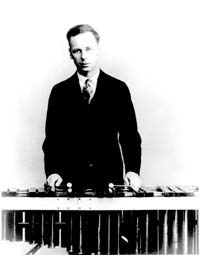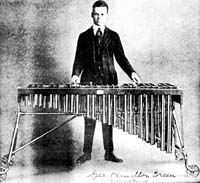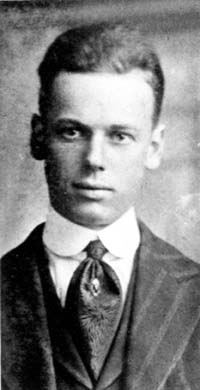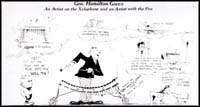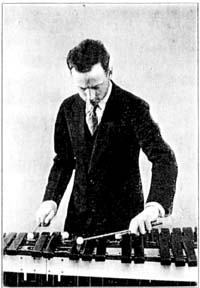George Hamilton Green
George Hamilton Green (1893-1970). Xylophone virtuoso George Hamilton Green was born in Omaha, Nebraska on May 23, 1893. His grandfather, Joseph Green, was a violinist and violin maker in New York City, but when he moved to Omaha, he became a conductor and baritone horn soloist. George Hamilton Green’s father (G. H. Green, Sr.) followed his father in becoming a coronet soloist, arranger, and conductor of the Seventh Ward Silver Cornet Band.
George and his older brother Joseph, also an accomplished xylophonist, began their musical training at the piano. However, they soon convinced their father to purchase them a xylophone, “a small, awkward-looking instrument of two octaves, some of the bars being more narrow than others. It had no resonators and no stand … [but] it seemed wonderful, the most marvelous thing we had ever seen.” The boys soon built a replica so they could both practice at the same time.
George began playing solos with his father’s band at age twelve and was playing vaudeville engagements by the summer of 1912. From Chicago, he moved to New York in 1915 and quickly earned rave reviews for “his touch, his attack, his technique, and his powers of interpretation.” Praising their new Edison artist in 1917, the Edison Phonograph Monthly proclaimed: “Critics who are familiar with the possibilities of the xylophone concede that George Hamilton Green of Chicago is one of, if not the greatest xylophone players in the world.”
In addition to almost single-handedly inventing xylophone technique, Green developed an extensive popular recital repertoire for the instrument. By 1916, Green claimed a repertoire of nearly three hundred standard overtures, rhapsodies, fantasies, concert waltzes, transcriptions of violin concerto and concert piano pieces. His list of original works includes novelties, salon waltzes, popular dance tunes, a remarkable collection of ragtime tunes – all illustrating his inimitable technique and a highly original musical mind. Many of these works were quickly published and some are still available in modern editions.
- Photo reproduced from 1925 Leedy Xylophones and Marimbas catalog. Gerhardt Collection
- Photo reproduced from 1925 Leedy Xylophones and Marimbas catalog. Gerhardt Collection
- Photo reproduced from Composers and Artists whose Art is Re-Created by Edison’s New Art (c. 1920), Thomas A. Edison, Inc. Gerhardt Collection
- Photo reproduced from Composers and Artists whose Art is Re-Created by Edison’s New Art (c. 1920), Thomas A. Edison, Inc. Gerhardt Collection
- Photos courtesy James A. Strain. Cartoon reprinted from Leedy Drum Topics (April 1927)
George Hamilton Green’s recording career began in 1917 with a series of six xylophone solos for Edison, and he remained with the company until 1928. Before their recording careers were over, he and his brother Joe recorded over 150 “sides” as leaders of their own groups, recording under various ensemble names, for all the record labels, including the big three – Edison, Victor, and Columbia. He was able to improvise intricate obbligato lines, as well as highly syncopated novelty ragtime rhythms, both of which give his recordings a great vitality.
With his brother Joe, he was a founding member of the Green Brothers’ Xylophone Orchestra and the Green Brothers Novelty Band (Orchestra). Their brother, Lewis, born in 1910, joined the Novelty Band in 1928 to play banjo and guitar. The Green brothers’ xylophone playing and drumming would be heard in the waltzes, one-steps, two-steps, and the fox-trots of a number of top recording bands, including Earl Fuller’s Rector House Orchestra, Fred Van Eps quartet, and the Yerkes Jazarimba Orchestra, directed by another popular xylophone player, Harry A. Yerkes. Green also performed with Victor Arden (piano) and F. Wheeler Wadsworth (alto saxophone) as the All Star Trio.
George Green co-authored a correspondence course for marimba and xylophone with Joseph, which they sold by mail order. Each of the fifty lessons cost one dollar. At one time, their correspondence course attracted an international enrollment of over 1500 students. Complete editions of the lessons are now prized among collectors.
George Hamilton Green was a mysterious genius with a complex personality. Toward the end of the xylophone’s “Golden Age,” he joined the staff of a major broadcasting network, but in the middle of a radio program in 1946, Green put down his mallets and walked out of the studio. Apparently he never played the xylophone in public again.
Nevertheless, he spent another twenty-four years as a productive, creative artist. Always a talented visual artist, his cartoons and illustrations appeared regularly in such journals as the Saturday Evening Post and Collier’s until his death in 1970. He was inducted into the Percussive Arts Society Hall of Fame in 1983.
This information is taken from the liner notes of the Eastman Marimba Band’s “Nola” (Mercury Recording SRI 75108, 1976). See also William Cahn’s The Xylophone in Acoustic Recordings, and other sources collected by Edwin Gerhardt.





